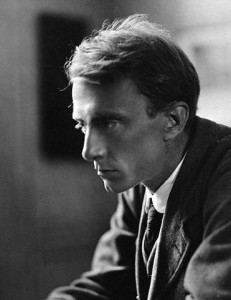I’ve just been reading with great enjoyment the new biography of Edward Thomas by Jean Moorcroft Wilson. I’ve written about Thomas before, after we visited his grave last year. He’s a difficult and complicated person who somehow draws you back and back again to his poems; deceptively calm, they give you that sense of encountering something familiar that you recognise instantly, dusty nettles in the corner of a yard, a tiny railway station glimpsed in passing, a road gleaming after rain, making you feel that he’s writing for you personally. There’s something about their quiet strength that reminds me of the work of Eric Ravillious, whose work we visited the Dulwich gallery last week to see; both use pastel colours, sometimes radiant , sometimes sombre, turning a keen gaze upon the everyday and apparently banal. Ravillious too gives you the sense of transmuting your own experience, a third-class railway carriage (even for those too young to remember them) a greenhouse full of cyclamen, into something timeless and archetypical. And both men, the writer and the painter, demonstrate a quality usually described as ‘quintessentially English.’ To try and describe what this means would require a whole other blog post, would have to take in music, Elgar and Vaughan Williams as well, and I fear would be beyond my fairly puny critical powers, so I shall leave it at that.
I’ve chosen one of my favourite Thomas poems, ‘Words’, in which he uses the conceit that words choose the writer rather than the other way around. But Thomas’s choice of words, and his ability to position them so as to draw out their cadences, is exquisite. Who else, in ‘Adlestrop’ could make the names of two English counties into one of the most beautiful lines in poetry?
Words
![]() UT of us all
UT of us all
That make rhymes
